Acura Integra 2000 Sedan Owner's Guide
Manufacturer: ACURA, Model Year: 2000, Model line: Integra, Model: Acura Integra 2000Pages: 273, PDF Size: 4.4 MB
Page 21 of 273

Protectin
g Adult s
6.Adjus t th e Steerin g Whee l
Adjust the steering wheel, if needed, so that the wheel points toward your
chest, not toward your face.
Pointing the steering wheel toward
your chest provides optimal protection from the airbag.
See page 65 for how to adjust the
steering wheel.
7.Maintai
n a Prope r Sittin g
Positio n
After all occupants have adjusted their seats and put on seat belts, it is
very important that they continue to sit upright, well back in their seats,
with their feet on the floor, until the car is parked and the engine is off.
Sitting improperly can increase the
chance of injury during a crash. For
example, if an occupant slouches,
lies down, turns sideways, sits
forward, leans forward or sideways, or puts one or both feet up, the
chance of injury during a crash is
greatly increased.
In addition, an occupant who is out of
position in the front seat can be seriously or fatally injured by
striking interior parts of the car, or
by being struck by an inflating airbag. Remember, to get the best
protection from your car's airbags
and other safety features, you must
sit properly and wear your seat belt
properly.
Drive r an d Passenge r Safet y
Sitting improperly or out of
position can result in serious
injury or death in a crash.
Always sit upright, well back in
the seat, with your feet on the
floor.
Page 22 of 273

Protectin
g Adult s
Advic e fo r Pregnan t Wome n
Because protecting the mother is the
best way to protect her unborn child, a pregnant woman should always
wear a seat belt whenever she drives or rides in a car.
We recommend that pregnant women use a lap/shoulder belt
whenever possible. Remember tokeep the lap portion of the belt as
low as possible across your hips. Pregnant women should also sit
upright and as far back as possible
from the steering wheel or dashboard. This will reduce the risk
of injuries to both the mother and
her unborn child that can be caused
by a crash or an inflating airbag.
Each time you have a check-up, ask
your doctor if it's okay for you to drive. Additiona
l Safet y Precaution s
Two people should never use the
same seat belt. If they do, they
could be very seriously injured in a
crash.
Do not put any accessories on seat
belts. Devices intended to improve
occupant comfort or reposition the
shoulder part of a seat belt can
severely compromise the
protective capability of the seat belt and increase the chance of
serious injury in a crash.
CONTINUED
Drive r an d Passenge r Safet y
Page 23 of 273

Protectin
g Adult s
Do not place hard or sharp objects
between yourself and an airbag.
Carrying hard or sharp objects on
your lap, or driving with a pipe or other sharp object in your mouth,
can result in injuries if your
airbags inflate.
Do not attach or place objects on
the front airbag covers. Any object
attached to or placed on the covers
marked "SRS AIRBAG," in the
center of the steering wheel and on top of the dashboard, could
interfere with the proper operation of the airbags. Or, if the airbags
inflate, the objects could be
propelled inside the car and hurt
someone.
Keep your hands and arms away
from the airbag covers. If your
hands or arms are close to the airbag covers in the center of thesteering wheel and on top of the
dashboard, they could be injured if the airbags inflate.
Drive r an d Passenge r Safet y
Page 24 of 273
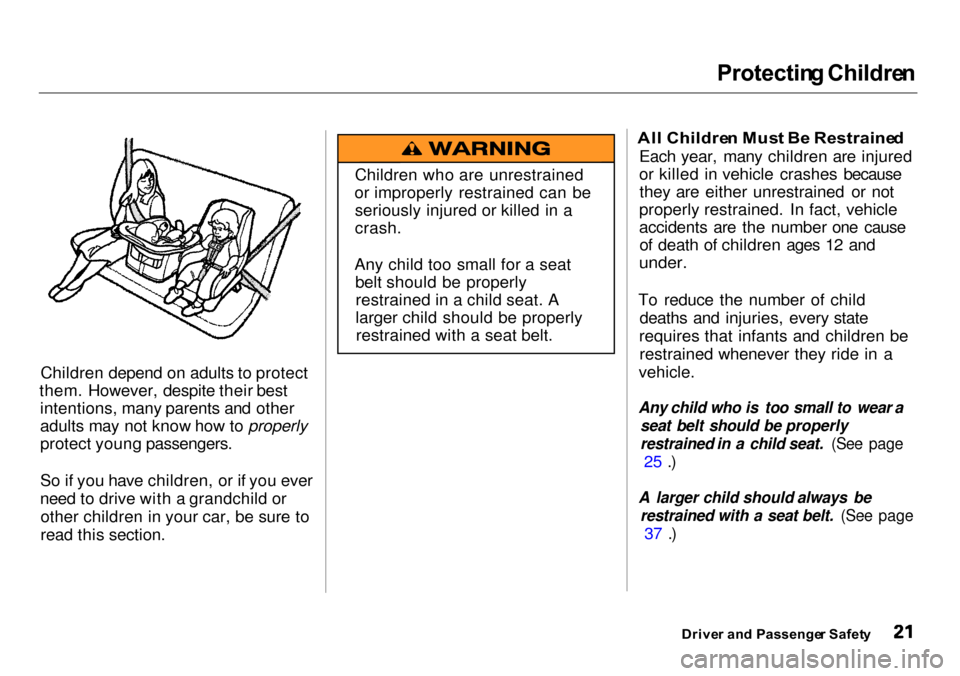
Protectin
g Childre n
Children depend on adults to protect
them. However, despite their best intentions, many parents and other
adults may not know how to properly
protect young passengers.
So if you have children, or if you ever
need to drive with a grandchild or
other children in your car, be sure to
read this section.
Al
l Childre n Mus t B e Restraine d
Each year, many children are injured
or killed in vehicle crashes because they are either unrestrained or not
properly restrained. In fact, vehicle
accidents are the number one cause of death of children ages 12 and
under.
To reduce the number of child deaths and injuries, every state
requires that infants and children be restrained whenever they ride in a
vehicle.
Any child who is too small to wear a seat belt should be properly
restrained in a child seat. (See page
25 .)
A larger child should always be restrained with a seat belt. (See page
37 .)
Driver an d Passenge r Safet y
Children who are unrestrained
or improperly restrained can be seriously injured or killed in a
crash.
Any child too small for a seat belt should be properlyrestrained in a child seat. A
larger child should be properlyrestrained with a seat belt.
Page 25 of 273
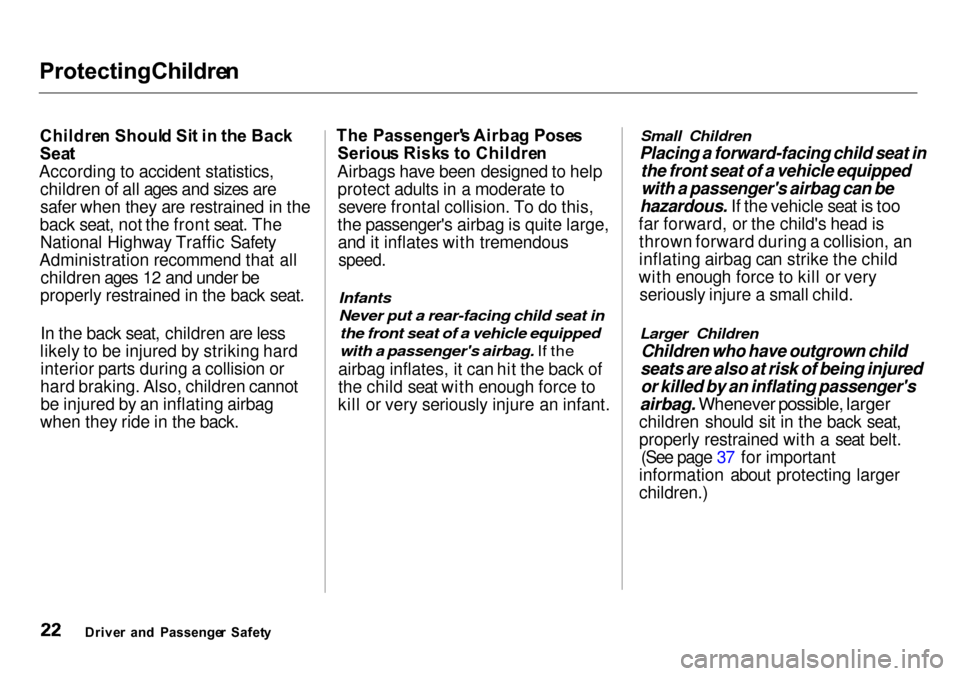
Protecting
Childre n
Childre n Shoul d Si t i n th e Bac k
Sea t
According to accident statistics, children of all ages and sizes are
safer when they are restrained in the
back seat, not the front seat. The National Highway Traffic Safety
Administration recommend that all children ages 12 and under be
properly restrained in the back seat.
In the back seat, children are less
likely to be injured by striking hard interior parts during a collision or
hard braking. Also, children cannot be injured by an inflating airbag
when they ride in the back. Th
e Passenger' s Airba g Pose s
Seriou s Risk s t o Childre n
Airbags have been designed to help protect adults in a moderate to severe frontal collision. To do this,
the passenger's airbag is quite large, and it inflates with tremendous
speed.
Infants
Never put a rear-facing child seat in the front seat of a vehicle equipped
with a passenger's airbag. If the
airbag inflates, it can hit the back of
the child seat with enough force to
kill or very seriously injure an infant.
Small Children
Placing a forward-facing child seat in the front seat of a vehicle equippedwith a passenger's airbag can be
hazardous. If the vehicle seat is too
far forward, or the child's head is thrown forward during a collision, an
inflating airbag can strike the child
with enough force to kill or very seriously injure a small child.
Larger Children
Children who have outgrown child
seats are also at risk of being injured or killed by an inflating passenger's
airbag. Whenever possible, larger
children should sit in the back seat,
properly restrained with a seat belt. (See page 37 for important
information about protecting larger
children.)
Drive r an d Passenge r Safet y
Page 26 of 273

Protectin
g Childre n
U.S. Models
To remind you of the passenger's airbag hazards, and that children
must be properly restrained in the
back seat, your car has warning
labels on the dashboard and on the
driver's and front passenger's visors.
Please read and follow the
instructions on these labels. I
f Yo u Mus t Driv e wit h Severa l
Childre n
Your vehicle has three seating positions in the back seat wherechildren can be properly restrained.
If you ever have to carry more than
three children in your vehicle:
Place the largest child in the front
seat, provided the child is large
enough to wear a seat belt
properly (see page 37 ).
Move the vehicle seat as far to the
rear as possible (see page 12).
Have the child sit upright and well
back in the seat (see page 18). Make sure the seat belt is properly
positioned and secured (see page 15).
Drive r an d Passenge r Safet y
Page 27 of 273

Protectin
g Childre n
I f a Chil d Require s Clos e
Attentio n
Many parents say they prefer to put an infant or small child in the front
passenger seat so they can watch the
child, or because the child requires
attention.
Placing a child in the front seat
exposes the child to hazards from
the airbag, and paying close attention to a child distracts the
driver from the important tasks of
driving, placing both of you at risk.
If a child requires physical attention or frequent visual contact, we
strongly recommend that another
adult ride with the child in the back
seat. The back seat is far safer for a
child than the front. Additiona
l Safet y Precaution s
Use childproof door locks to
prevent children from opening the
doors. Using this feature will
prevent children from opening the doors and accidentally falling out (see page 73 ).
Use the main power window
switch to prevent children from
opening the rear windows. Using
this feature will prevent children
from playing with the windows,
which could expose them to
hazards or distract the driver (see
page 79 ).
Do not leave children alone in your
vehicle. Leaving children without
adult supervision is illegal in most states and Canadian provinces,
and can be very hazardous. For
example, infants and small children left in a vehicle on a hot
day can die from heatstroke. And
children left alone with the key in the ignition can accidentally set
the vehicle in motion, possibly
injuring themselves or others.
Drive r an d Passenge r Safet y
Page 28 of 273
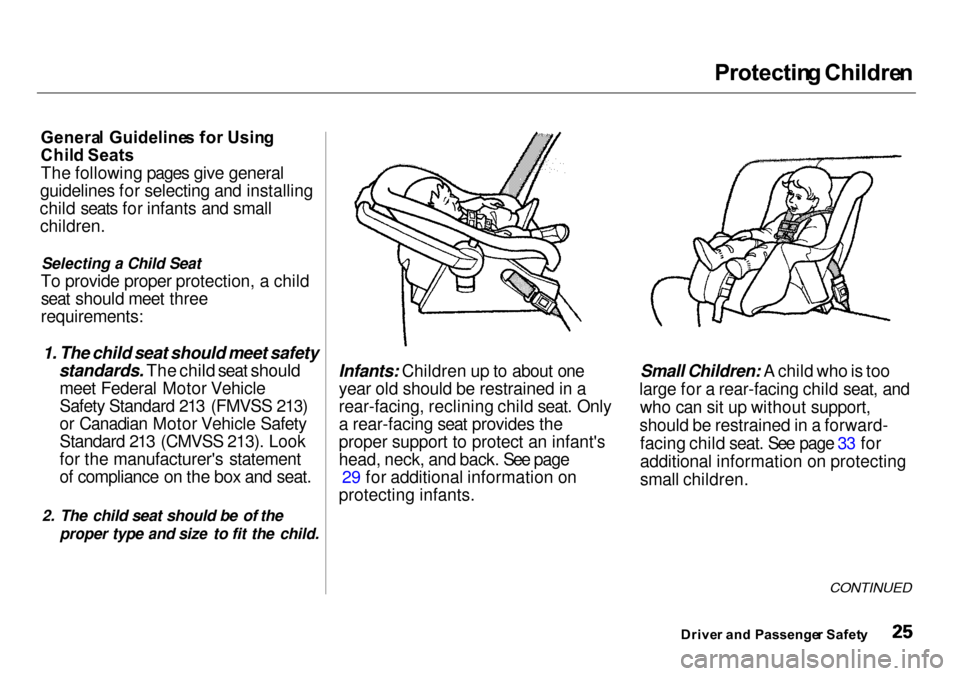
Protectin
g Childre n
Genera l Guideline s fo r Usin g
Chil d Seats
The following pages give general
guidelines for selecting and installing
child seats for infants and small children.
Selecting a Child Seat
To provide proper protection, a child seat should meet three
requirements:
1. The child seat should meet safety
standards. The child seat should
meet Federal Motor Vehicle
Safety Standard 213 (FMVSS 213)
or Canadian Motor Vehicle Safety
Standard 213 (CMVSS 213). Look
for the manufacturer's statement
of compliance on the box and seat.
2. The child seat should be of the proper type and size to fit the child. Infants: Children up to about one
year old should be restrained in a
rear-facing, reclining child seat. Only
a rear-facing seat provides the
proper support to protect an infant's
head, neck, and back. See page 29 for additional information on
protecting infants. Small Children: A child who is too
large for a rear-facing child seat, and who can sit up without support,
should be restrained in a forward- facing child seat. See page 33 for
additional information on protecting
small children.
CONTINUED
Drive r an d Passenge r Safet y
Page 29 of 273
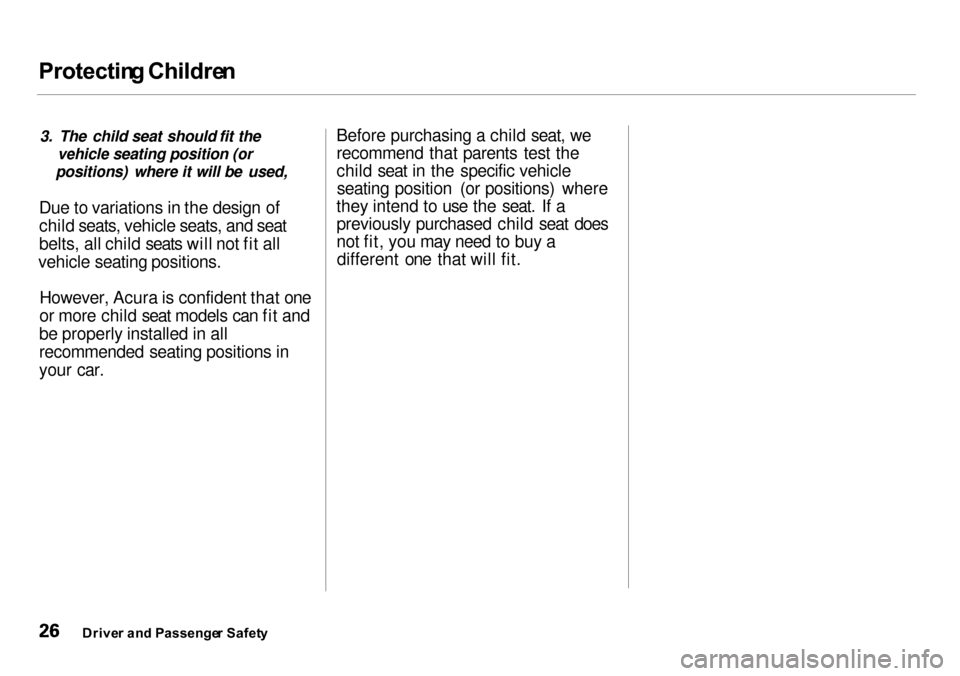
Protectin
g Childre n
3. The child seat should fit the vehicle seating position (or
positions) where it will be used,
Due to variations in the design of
child seats, vehicle seats, and seat
belts, all child seats will not fit all
vehicle seating positions.
However, Acura is confident that one
or more child seat models can fit and
be properly installed in all
recommended seating positions in
your car. Before purchasing a child seat, we
recommend that parents test the
child seat in the specific vehicle
seating position (or positions) where
they intend to use the seat. If a
previously purchased child seat does
not fit, you may need to buy a different one that will fit.
Drive r an d Passenge r Safet y
Page 30 of 273
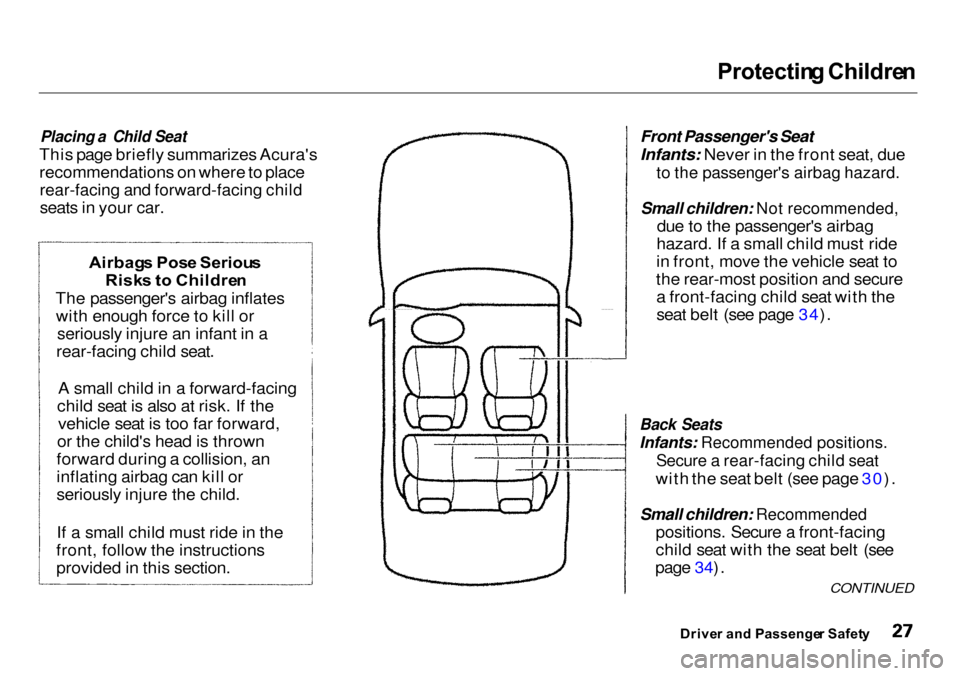
Protectin
g Childre n
Placing a Child Seat
This page briefly summarizes Acura's recommendations on where to place
rear-facing and forward-facing child
seats in your car.
Front Passenger's Seat
Infants: Never in the front seat, due
to the passenger's airbag hazard.
Small children: Not recommended,
due to the passenger's airbag
hazard. If a small child must ride
in front, move the vehicle seat to
the rear-most position and secure a front-facing child seat with the
seat belt (see page 34).
Back Seats
Infants: Recommended positions.
Secure a rear-facing child seat
with the seat belt (see page 30).
Small children: Recommended
positions. Secure a front-facing
child seat with the seat belt (see
page 34).
Drive r an d Passenge r Safet y
CONTINUED
Airbag
s Pos e Seriou s
Risk s t o Childre n
The passenger's airbag inflates with enough force to kill or seriously injure an infant in a
rear-facing child seat.
A small child in a forward-facing
child seat is also at risk. If the vehicle seat is too far forward,
or the child's head is thrown
forward during a collision, an
inflating airbag can kill or
seriously injure the child.
If a small child must ride in the
front, follow the instructions
provided in this section.